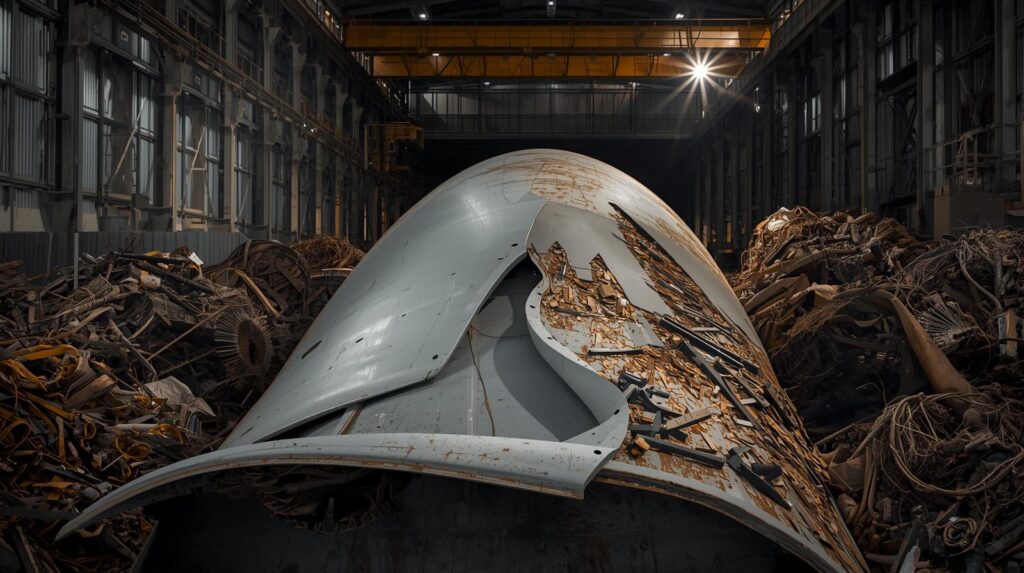Wind turbines power clean energy, slashing fossil fuel use. But their massive blades, often as long as a football field, pose a recycling challenge. When they wear out after 20-25 years, disposing of them sustainably is tough. We need solutions to keep wind energy truly green.
Why Wind Turbine Blades Are Hard to Recycle
Blades are made of fiberglass, carbon fiber, and epoxy resin. These composites are strong but hard to break down. Unlike recyclable plastics, they resist melting or reshaping. Their huge size also makes transport to recycling facilities a logistical mess.
The Scale of the Problem with Turbine Blades
Thousands of turbines from the 1990s are now retiring. By 2030, the U.S. alone could see 8,000 blades discarded yearly. Globally, blade waste might hit 40 million tons by 2050. Without action, landfills will pile up with these giant structures.
Environmental Impact of Turbine Blade Waste
Dumping blades in landfills wastes space and releases methane. Burning them creates toxic fumes, harming the environment. This undermines wind energy’s eco-friendly promise. Recycling is critical to maintain its climate-fighting benefits.

Mechanical Recycling: A Starting Point
Mechanical recycling grinds blades into small bits. These can be used in cement or asphalt. It’s simple but produces lower-value materials. The process also uses significant energy, limiting its appeal.
Chemical Recycling: Higher Quality, Higher Cost
Chemical recycling uses solvents to separate fibers from resin. Recovered materials, like carbon fiber, can be reused in cars or planes. It’s effective but expensive and needs specialized facilities. Scaling it up remains a challenge.
Thermal Recycling Through Pyrolysis
Pyrolysis heats blades in low-oxygen settings to break them down. It yields fibers, gases, and oils for reuse. This method recovers valuable materials but requires lots of energy. It’s still being refined for wider use.
Repurposing Blades Creatively
Instead of recycling, some turbine blades are reused as-is. They’ve become bike sheds, bridges, or playground structures. In Denmark, Re-Wind turns blades into noise barriers. These projects are creative but can’t handle the full waste volume.
Designing turbine Blades for Recycling
New blades are being designed for easier recycling. Thermoplastic resins, unlike epoxy, can be melted and reshaped. Modular designs could allow parts to be reused. These innovations aim to reduce waste from the start.
Bio-Based Materials as a Game-Changer
Researchers are exploring plant-based resins for blades. The National Renewable Energy Laboratory is testing bio-based options. These could replace petroleum-based materials, cutting environmental impact. It’s a promising step toward sustainability.
Recyclable Blades in Action
Siemens Gamesa launched the first fully recyclable blade in 2021. It uses mild chemicals to break down materials. Such designs could become standard. They make recycling easier and less wasteful.

Advanced Manufacturing for the Future
3D printing could create blades with recycling in mind. Automated production might use fewer materials. Sensors could monitor blade wear, extending their life. These ideas are still developing but show potential.
The Role of Policy in Recycling
Governments are pushing for solutions. The EU bans landfilling composite waste, spurring innovation. Denmark aims for fully recyclable turbines by 2030. Policies like these drive progress in blade recycling.
Collaboration Drives Change
Wind companies, universities, and waste firms are teaming up. The U.S. Department of Energy funds recycling startups. These partnerships turn lab ideas into real solutions. Collaboration is key to tackling blade waste.
Economic Challenges of Recycling
Recycling turbine blades is costly. Building facilities and transporting blades isn’t cheap. Chemical recycling produces high-quality materials but struggles to compete with cheaper virgin materials. Balancing cost and sustainability is tricky.
Energy Trade-Offs in Recycling
Some recycling methods use lots of energy. This could offset wind energy’s environmental gains. Finding low-energy processes is crucial. The industry must prioritize efficiency to stay green.
Scaling Up Recycling Efforts
Current solutions can’t yet handle millions of tons of blade waste. Facilities and processes need to scale up fast. Investment in infrastructure is essential. Without it, landfills will remain a fallback.
Building a Market for Recycled Materials
Recycled blade materials need buyers. If construction firms use them in roads or buildings, demand grows. This could lower costs and make recycling viable. A strong market is critical for success.
Toward a Circular Economy
A circular economy reuses blades with minimal waste. It starts with better design and ends with recycling. Creating demand for recycled materials closes the loop. This vision makes wind energy fully sustainable.
The Role of Consumers and Policymakers
Consumers can support green energy providers. Policymakers can fund research or ban landfilling. These actions push the industry forward. Every step counts in reducing blade waste.
The Future of Blade Recycling
Blade recycling is still evolving, but progress is real. From recyclable designs to creative repurposing, solutions are emerging. With teamwork and innovation, wind energy can stay clean. The future looks promising for sustainable turbines.
Why It Matters
Wind power fights climate change, but blade waste is a hurdle. Recycling keeps it eco-friendly. Solving this ensures wind energy’s legacy. It’s about building a greener tomorrow, one blade at a time. If you are curious about climatic changes read Global Warming vs. Climate Change,
